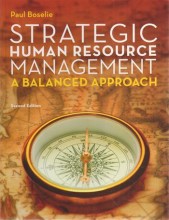Human Resource Management and Performance: Adding value through people/managment en prestaties - Competitve advantage and critical HR goals
8 important questions on Human Resource Management and Performance: Adding value through people/managment en prestaties - Competitve advantage and critical HR goals
In what way does the model of Boxall & Purcell differ from Barney?
However, the VRIO framework focuses on the way organizations can achieve sustained competitive advantage.
That's why Boxall & Purcell build up on the model of Barney.
What is the difference between Ultimate business goals and organizational performance?
The organizational performance are critical and critical non-HR goals. After you have formulated the UBG's, you need to link them to critical and non-critical HR goals.
What is the difference between the critical HR and critical non-HR goals?
The critical non-HR goals are goals that might include desired outcomes for sales, market share, and so on.
- Higher grades + faster learning
- Never study anything twice
- 100% sure, 100% understanding
What is the disadvantage of the Boxell & Purcell model?
What are the three types of critical HR goals that Boxall & Purcell distunguish?
- Quality represents the effectiveness of the organization's services and products, often directly linked to customer demands and satisfaction.
2. Organization flexibility; the capacity to change and/or adapt.
- Numerical, functional and mental flexibility.
3. Social legitimacy and employment citizenship; legitimacy of an organization to the outside environment (on macro level).
- Micro level; the organization's legitimacy to its own employees
- Legitimacy & fairness are part of the moral side of managing people
Why is social legitimacy underdeveloped?
What are the three steps of the model of Boxall & Purcell
2. Link the UBG's to critical HR and critical non-HR goals
3. Link the critical HR goals to HR outcomes
What are the four parts of the model of Boxall & Purcell?
2. HRM outcomes
3. Performance
4. Above is influenced by contigency and/or control variables: organizational level e.g. Age, size, technology and individual employee level e.g. Age, gender, education level, experience.
The question on the page originate from the summary of the following study material:
- A unique study and practice tool
- Never study anything twice again
- Get the grades you hope for
- 100% sure, 100% understanding
































